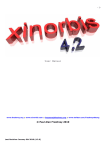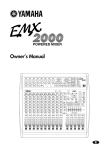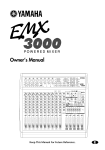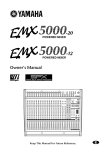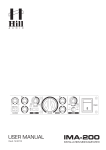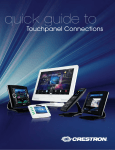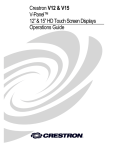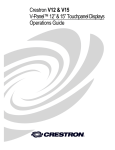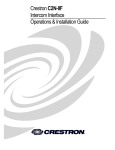Download Crestron CEN-TIA Specifications
Transcript
Crestron CEN-TIA Telephone Interface Module Operations Guide This document was prepared and written by the Technical Documentation department at: Crestron Electronics, Inc. 15 Volvo Drive Rockleigh, NJ 07647 1-888-CRESTRON All brand names, product names and trademarks are the property of their respective owners. ©2007 Crestron Electronics, Inc. Crestron CEN-TIA Telephone Interface Module Contents Telephone Interface Module: CEN-TIA 1 Introduction ............................................................................................................................... 1 Features and Functions ................................................................................................ 1 Internal Block Diagram ............................................................................................... 2 Specifications .............................................................................................................. 3 Physical Description.................................................................................................... 3 Industry Compliance ................................................................................................... 6 Setup .......................................................................................................................................... 8 Network Wiring........................................................................................................... 8 Identity Code ............................................................................................................... 8 Hardware Hookup ....................................................................................................... 9 Programming Software............................................................................................................ 11 Earliest Version Software Requirements for the PC ................................................. 11 Programming with Crestron SystemBuilder.............................................................. 11 Programming with Crestron Toolbox Text Console.................................................. 12 Programming with Crestron Toolbox CEN-TIA Menu Builder................................ 14 Programming with SIMPL Windows ........................................................................ 14 Example Program ...................................................................................................... 17 Uploading and Upgrading........................................................................................................ 18 Establishing Communication..................................................................................... 18 Programs and Firmware ............................................................................................ 20 Program Checks ........................................................................................................ 21 Operation ................................................................................................................................. 22 Problem Solving ...................................................................................................................... 23 Troubleshooting......................................................................................................... 23 Check Network Wiring.............................................................................................. 24 Reference Documents................................................................................................ 25 Further Inquiries ........................................................................................................ 25 Future Updates .......................................................................................................... 25 Return and Warranty Policies .................................................................................................. 26 Merchandise Returns / Repair Service ...................................................................... 26 CRESTRON Limited Warranty................................................................................. 26 Operations Guide – DOC. 6414 Contents • i Crestron CEN-TIA Telephone Interface Module Telephone Interface Module: CEN-TIA Introduction Features and Functions • • • • • • • • • Remote control access from any phone Custom door chime, ringer and alarm sounds Personalized voice prompts Caller ID (CID) Telephone paging for multiroom audio systems Push-To-Talk half-duplex speakerphone Easy setup via phone and PC software Microsoft Outlook Address Book import compatibility Palm database import compatibility DTMF Control Interface Use your mobile phone to remotely turn on lights, adjust air conditioning, and arm/disarm security. Using standard Dual-Tone Multi-Frequency (DTMF) signals, the CEN-TIA affords telephone keypad control of any automation system function, providing a prompt-driven user-interface that is simple to use. Configuration software provided with the CEN-TIA makes it easy to set up a menu of friendly voice commands using the preloaded voice prompts, or your own custom audio files, for personalized remote control of your home or office. The CEN-TIA can also dial out to your mobile phone to alert you to an alarm condition or other system event. Audio Signal Generator Loaded with your own custom WAV or MP3 audio files, the CEN-TIA can be used to generate high-quality door chimes and alarm sounds, and even create unique telephone ring tones to identify known callers based on Caller ID. With memory capacity expandable up to 1 GB, the CEN-TIA can easily support several hours of full-frequency stereo audio files. Operations Guide – DOC. 6414 Telephone Interface Module: CEN-TIA • 1 Telephone Interface Module Crestron CEN-TIA Caller ID See who is calling before you answer by displaying Caller ID (CID) information on every touchpanel. Manage missed calls easily with complete caller information and management options displayed on the touchpanel screen. Telephone Paging The CEN-TIA adds telephone paging capability to any Crestron Home® audio distribution system, allowing sophisticated zone-paging from any telephone to room speakers throughout the house. Speakerphone Enable speakerphone capability on your Crestron® touchpanel. The CEN-TIA connects directly to a standard phone line, or to your phone system's analog extension port to provide a single-line, push-to-talk half-duplex speakerphone interface for any touchpanel with built-in microphone and speakers. Integrated with the C2N-IADS30x24 Intercom Distribution Switcher, the CEN-TIA can enable speakerphone capabilities for multiple touchpanels throughout the house. Outlook and Palm Address Book Import Compatibility Both Microsoft Outlook Address Book and Palm Desktop Address Book can be imported into the CEN-TIA. Refer to the Toolbox help file for information on this procedure. Internal Block Diagram The following diagram represents the electrical details of the CEN-TIA. For more information, refer to “Operation” on page 22. Internal Block Diagram of the CEN-TIA CODEC DAA LINE OUT PHONE OUT PHONE IN LINE IN STEREO PHONE LINE DSP CROSS POINT MP3 LINE OUT STEREO FLASH/ SDRAM RECORD PLAY BACK AUDIO DAC AUDIO CODEC COLD FIRE CRESNET USB MP3 DECODER ETHERNET MMC/ FLASH 2 • Telephone Interface Module: CEN-TIA Operations Guide – DOC. 6414 Crestron CEN-TIA Telephone Interface Module Specifications Specifications for the CEN-TIA are listed in the following table. CEN-TIA Specifications SPECIFICATION DETAILS Audio: Frequency Response (AUDIO OUT) 20Hz to 20kHz ±0.5dB from MP3 file or AUDIO IN sources; 300Hz to 3kHz –3dB from PHONE LINE source; 300Hz to 3kHz –3dB from WAV file messages Frequency Response (PHONE LINE) 300Hz to 3kHz –3dB Signal/Noise Ratio 94 dB A-weighted at AUDIO OUT THD + N 0.05% A-weighted at AUDIO OUT MP3 File Support 44.1 kHz sampling rate, 64 to 128 Kb/s bit rate WAV File Support 8 and 16-bit PCM, mono, 8 kHz sampling rate Multimedia Memory Card 32 MB included, 1 GB maximum; stores MenuBuilder program and audio files Cresnet® Power Usage 7 Watts (0.3 Amp @ 24 Volts DC) Default Net ID 49 Minimum 2-Series Control System Update File1, 2 Version 3.155.1143.CUZ or later Operating Environment Temperature Humidity Enclosure 32° to 122°F (0° to 50°C) 10% to 90% RH (non-condensing) Black metal, 0.5U 19” rack-mountable using optional ST-RMK (sold separately) Dimensions Height: Width: Depth: Weight 1. 2. 1.80 in (4.57 cm), 1.70 in (4.32 cm) without feet 7.07 in (17.96 cm) 6.36 in (16.15 cm) 1.8 lbs (0.9 kg) The latest software versions can be obtained from the Crestron website. Refer to the NOTE following these footnotes. Crestron 2-Series control systems include the AV2 and PRO2. Consult the latest Crestron Product Catalog for a complete list of 2-Series control systems. NOTE: Crestron software and any files on the website are for authorized Crestron dealers and Crestron Authorized Independent Programmers (CAIP) only. New users may be required to register to obtain access to certain areas of the site (including the FTP site). Physical Description This section provides information on the connections, controls, and indicators available on your CEN-TIA. Operations Guide – DOC. 6414 Telephone Interface Module: CEN-TIA • 3 Telephone Interface Module Crestron CEN-TIA CEN-TIA Physical View CEN-TIA Overall Dimensions 1 2 4 3 5 7 6 7.07 in (17.96 cm) 6.36 in (16.15 cm) 8 9 10 11 12 13 14 15 1.80 in (4.57 cm) 4 • Telephone Interface Module: CEN-TIA Operations Guide – DOC. 6414 Crestron CEN-TIA Telephone Interface Module Connectors, Controls, & Indicators # CONNECTORS*, CONTROLS, & INDICATORS DESCRIPTION 1 PWR LED Green LED indicates 24 Volts DC power supplied from Cresnet control network. 2 NET LED Yellow LED indicates communication with Cresnet System. 3 ACT LED Red LED indicates internal processing activity. 4 OFF HOOK 5 LAN LNK LED Green LED indicates Ethernet link status. 6 LAN ACT LED Yellow LED indicates Ethernet activity. 7 USB 8 PHONE LINE 9 LAN GREEN LED PIN 8 10 YELLOW LED Miniature pushbutton and green LED initiates and indicates “off-hook” connection to phone line. Type B “female” USB port. 6-pin RJ11 female; for single-line POTS telephone line or analog extension port. For programmatic interface with Crestron Toolbox CEN-TIA Menu Builder. (1) 8-wire RJ-45 with two LED indicators; 10BaseT/100BaseTX Ethernet port, auto-negotiating; Green LED indicates link status; Yellow LED indicates Ethernet activity PIN 1 MEMORY PIN SIGNAL PIN SIGNAL 1 2 3 4 TX + TX RC+ N/C 5 6 7 8 N/C RC N/C N/C (1) MMC compatible card slot; Accepts Multimedia memory card up to 1 GB (32 Mb included) CAUTION: Install with label facing up only. Installing the memory card upside down will render it inoperable and may cause damage. 11 AUDIO IN 12 AUDIO OUT (1) 5-pin 3.5mm detachable terminal block; Balanced/unbalanced stereo line-level audio output; Output impedance: 200 ohms balanced; 100 ohms unbalanced; Maximum Output Level: 4 Vrms balaned, 2 Vrms unbalanced 13 SETUP LED & BUTTON (1) Miniature pushbutton and (1) red LED, used for touch-settable ID (TSID). (1) 5-pin 3.5mm detachable terminal block; Balanced/unbalanced stereo line-level audio input; Input Impedance: 20k ohms balanced, 10k ohms unbalanced; Maximum Input Level: 4Vrms balanced, 2 Vrms unbalanced (Continued on following page) Operations Guide – DOC. 6414 Telephone Interface Module: CEN-TIA • 5 Telephone Interface Module Crestron CEN-TIA Connectors, Controls, & Indicators (Continued) * # CONNECTORS*, CONTROLS, & INDICATORS DESCRIPTION 14 NET Four-position terminal block connector for data and power. Connects to Cresnet control network. Pin 1 (24) Power Pin 2 (Y) Data Pin 3 (Z) Data Pin 4 (G) Ground 15 GROUND (1) 6-32 screw, chassis ground lug Interface connectors for AUDIO IN, AUDIO OUT, and NET, ports are provided with the unit. Industry Compliance NOTE: This equipment meets the applicable Industry Canada Terminal Equipment Technical Specifications. This is confirmed by the registration number. The abbreviations, IC, before the registration number signifies that registration was performed based on a Declaration of Conformity indicating that Industry Canada technical specifications were met. It does not imply that Industry Canada approved the equipment. NOTE: The Ringer Equivalence Number (REN) for this terminal equipment is 0.1A. The REN assigned to each terminal equipment provides an indication of the maximum number of terminals allowed to be connected to a telephone interface. The termination on an interface may consist of any combination of devices subject only to the requirement that the sum of the Ringer Equivalence Numbers of all the devices does not exceed five. This equipment complies with Part 68 of the FCC rules and the requirements adopted by the ACTA. On the bottom of the unit is a label that contains, among other information, a product identifier in the format US:AAAEQ##TXXXX. If requested, this number must be provided to the telephone company. Applicable connector jack Universal Service Order Codes (“USOC”) for the Equipment is RJ11C. A plug and jack used to connect this equipment to the premises wiring and telephone network must comply with the applicable FCC Part 68 rules and requirements adopted by the ACTA. A compliant telephone cord and modular plug is provided with this product. It is designed to be connected to a compatible modular jack that is also compliant. The REN is used to determine the number of devices that may be connected to a telephone line. Excessive RENs on a telephone line may result in the devices not ringing in response to an incoming call. In most but not all areas, the sum of RENs should not exceed five (5.0). To be certain of the number of devices that may be connected to a line, as determined by the total RENs, contact the local telephone company. For products approved after July 23, 2001, the REN for this product is part of the product identifier that has the format US:AAAEQ##TXXXX. The digits represented by ## are the REN without a decimal point (e.g., 03 is a REN of 0.3). If this CEN-TIA causes harm to the telephone network, the telephone company will notify you in advance that temporary discontinuance of service may be required. But if advance notice isn't practical, the telephone company will notify the customer as soon as possible. Also, you will be advised of your right to file a complaint with the FCC if you believe it is necessary. 6 • Telephone Interface Module: CEN-TIA Operations Guide – DOC. 6414 Crestron CEN-TIA Telephone Interface Module The telephone company may make changes in its facilities, equipment, operations or procedures that could affect the operation of the equipment. If this happens the telephone company will provide advance notice in order for you to make necessary modifications to maintain uninterrupted service. If trouble is experienced with this CEN-TIA, for repair or warranty information, please contact Crestron customer service (refer to “Further Inquiries” on page 25. If the equipment is causing harm to the telephone network, the telephone company may request that you disconnect the equipment until the problem is resolved. Connection to party line service is subject to state tariffs. Contact the state public utility commission, public service commission or corporation commission for information. If your home has specially wired alarm equipment connected to the telephone line, ensure the installation of this equipment does not disable your alarm equipment. If you have questions about what will disable alarm equipment, consult your telephone company or a qualified installer. WHEN PROGRAMMING EMERGENCY NUMBERS AND(OR) MAKING TEST CALLS TO EMERGENCY NUMBERS: 3. Remain on the line and briefly explain to the dispatcher the reason for the call. 4. Perform such activities in the off-peak hours, such as early morning or late evenings. As of the date of manufacture, the CEN-TIA has been tested and found to comply with specifications for CE marking and standards per EMC and Radiocommunications Compliance Labelling. NOTE: This device complies with part 15 of the FCC rules. Operation is subject to the following two conditions: (1) this device may not cause harmful interference, and (2) this device must accept any interference received, including interference that may cause undesired operation. This equipment has been tested and found to comply with the limits for a Class B digital device, pursuant to part 15 of the FCC Rules. These limits are designed to provide reasonable protection against harmful interference in a residential installation. This equipment generates, uses and can radiate radio frequency energy and, if not installed and used in accordance with the instructions, may cause harmful interference to radio communications. However, there is no guarantee that interference will not occur in a particular installation. If this equipment does cause harmful interference to radio or television reception, which can be determined by turning the equipment off and on, the user is encouraged to try to correct the interference by one or more of the following measures: Reorient or relocate the receiving antenna. Increase the separation between the equipment and receiver. Connect the equipment into an outlet on a circuit different from that to which the receiver is connected. Consult the dealer or an experienced radio/TV technician for help. Operations Guide – DOC. 6414 Telephone Interface Module: CEN-TIA • 7 Telephone Interface Module Crestron CEN-TIA Setup Network Wiring When wiring the network, consider the following: • Use Crestron Certified Wire. • Use Crestron power supplies for Crestron equipment. • Provide sufficient power to the system. CAUTION: Insufficient power can lead to unpredictable results or damage to the equipment. Please use the Crestron Power Calculator to help calculate how much power is needed for the system (http://www.crestron.com/calculators). • For larger networks, Use a Cresnet Hub/Repeater (CNXHUB) to maintain signal quality For more details, refer to “Check Network Wiring” on page 24. The CEN-TIA uses Cresnet, USB and high-speed Ethernet for programmatic interface with Crestron’s Toolbox application. Please refer to the Toolbox help file. NOTE: The CEN-TIA is shipped with DHCP enabled (no default IP address). If it is desirable to manually set the IP address of the CEN-TIA (DHCP disabled) by using the Text Console in Toolbox. Refer to the Toolbox help file for further details. NOTE: The CEN-TIA can only be set up with the CEN-TIA Menu Builder tool that is included in Toolbox version 1.04.13 and later. NOTE: The Ethernet port on the CEN-TIA does not support Voice Over IP (VOIP). Identity Code The Net ID of the CEN-TIA has been factory set to 49. The Net IDs of multiple CEN-TIA devices in the same system must be unique if they are connected to the same Cresnet. Net IDs are changed from a personal computer (PC) via the Crestron Toolbox. When setting the Net ID, consider the following: • The Net ID of each unit must match an ID code specified in the SIMPL Windows program. • Each network device must have a unique Net ID. For more details, refer to the Crestron Toolbox help file. 8 • Telephone Interface Module: CEN-TIA Operations Guide – DOC. 6414 Crestron CEN-TIA Telephone Interface Module Hardware Hookup Ventilation The CEN-TIA should be used in a well-ventilated area. If the CEN-TIA is hot to the touch, consider using forced air ventilation and/or incrementing the spacing between units. To prevent overheating, do not operate this product in an area that exceeds the environmental temperature range listed in the table of specifications. Consideration must be given if installed in a closed or multi-unit rack assembly since the operating ambient temperature of the rack environment may be greater than the room ambient. Contact with thermal insulating materials should be avoided on all sides of the unit. Rack Mounting The CEN-TIA can be mounted in a rack with the ST-RMK (sold separately) or stacked with other equipment. WARNING: To prevent bodily injury when mounting or servicing this unit in a rack, take special precautions to ensure that the system remains stable. The following guidelines are provided to ensure your safety: • When mounting this unit in a partially filled rack, load the rack from the bottom to the top with the heaviest component at the bottom of the rack. • If the rack is provided with stabilizing devices, install the stabilizers before mounting or servicing the unit in the rack. NOTE: If rack mounting is not required, rubber feet are provided for tabletop mounting or stacking. Apply the feet near the corner edges on the underside of the unit. NOTE: Reliable earthing of rack-mounted equipment should be maintained. Particular attention should be given to supply connections other than direct connections to the branch circuit. (e.g., use of power strips). Connect the Device Make the necessary connections as called out in the illustration that follows this paragraph. Refer to “Network Wiring” on page 8 before attaching the 4-position terminal block connector. Apply power after all connections have been made. When making connections to the CEN-TIA, consider the following, use Crestron power supplies. Hardware Connections for the CEN-TIA (Front) CONSOLE INTERFACE: SERIAL COMMUNICATION WITH PC Operations Guide – DOC. 6414 Telephone Interface Module: CEN-TIA • 9 Telephone Interface Module Crestron CEN-TIA Hardware Connections for the CEN-TIA (Rear) MEMORY: MMC CARD SLOT PHONE LINE LAN: 10 BaseT/100 BaseTX HIGH SPEED ETHERNET TO LAN AUDIO OUTPUT: BALANCED AND UNBALANCED AUDIO SIGNALS TO AMP, ETC. AUDIO INPUT: BALANCED AND UNBALANCED AUDIO SIGNALS FROM LOCAL AUDIO SOURCES GROUND NET: TO CONTROL SYSTEM AND OTHER CRESNET DEVICES The CEN-TIA’s audio connections support both balanced and unbalanced line-level audio. These connectors are wired as shown in the following illustrations. Audio Input: Balanced and Unbalanced L R L +-G+- R +-G+- Shield + Left + Jumpers Shield + + Right Shield Audio Output: Balanced and Unbalanced L R L +-G+- R +-G+Shield + + + 10 • Telephone Interface Module: CEN-TIA Right Shield Right AMP Shield AMP Left + Left Operations Guide – DOC. 6414 Crestron CEN-TIA Telephone Interface Module Programming Software Have a question or comment about Crestron software? Answers to frequently asked questions (FAQs) can be viewed in the Online Help section of the Crestron website. To post a question or view questions you have submitted to Crestron’s True Blue Support, log in at http://support.crestron.com. First-time users will need to establish a user account. Earliest Version Software Requirements for the PC NOTE: Crestron recommends that you use the latest software to take advantage of the most recently released features. The latest software is available from the Crestron website. Crestron has developed an assortment of Windows®-based software tools to develop a Cresnet system. The following are the minimum recommended software versions for the PC: Software TASK REQUIRED SOFTWARE VERSION Program control system to operate CEN-TIA. SIMPL Windows version 2.07.15 or later with SIMPL+ Cross Compiler version 1.1 or later and Library Update 444 or later. Upload program and firmware, configure internal menus, events and commands. Crestron Toolbox 1.04.13 or later with the CEN-TIA Menu Builder tool. Program with simple wizards for systems using a CEN-TIA (optional but recommended). Crestron SystemBuilder™ version 3.0.18 or later (requires SIMPL Windows, VisionTools Pro-e, Crestron Database 18.4.3 and Crestron Engraver) with SystemBuilder Templates version 3.2.0 or later. Refer to software release notes or Crestron website for other required Crestron software packages. Programming with Crestron SystemBuilder Crestron SystemBuilder is the easiest method of programming but does not offer as much flexibility as SIMPL Windows. For additional details, download SystemBuilder from the Crestron website and examine the extensive help file. Operations Guide – DOC. 6414 Telephone Interface Module: CEN-TIA • 11 Telephone Interface Module Crestron CEN-TIA Programming with Crestron Toolbox Text Console There are a number of commands that can only be executed at the command line interface provided by the Crestron Toolbox Text Console. Text Console Commands COMMAND COMMAND SYNTAX DESCRIPTION ADDRBOOK ADD ADDRBOOK ADD <First Name> <Last Name> <Phone Number> Adds a record or person to the internal address book. ADDRBOOK BRIEF ADDRBOOK BRIEF <SortField> Displays a list of records in the address book sorted by last name. ADDRBOOK IMPORT ADDRBOOK IMPORT <Outlook | Palm> <Filename> Allows you to import a Microsoft Outlook or Palm address book. ADDRBOOK DELETE ADDRBOOK DELETE <Index> Deletes the address book or record. ADDRBOOK SAVE ADDRBOOK SAVE Saves the address book. ADDRBOOK VERBOSE ADDRBOOK VERBOSE <Sortfield> Displays all of the fields for every record in the address book. EMAIL EMAIL <filename> <recipient> <server> <from> Allows you to email a file from the CEN-TIA. MIXER MIXER <channel|*> [LEFT|RIGHT] <VOL|MUTE|BASS|TREBLE|BAL > <value> The MIXER command alone will display the status of the CEN-TIA internal mixer. The numerical values for Left/Right Volume, Bass and Treble are 0 thru 65535. Channels are: (2) MP3 Playback (2) WAV Playback (2) WAV Record Mute values are 0 (mute off) and 1 (mute on). ESTAT ESTAT Displays the status of active network connections. PAUSE PAUSE [PLAYERID] Pauses playback of an audio file. (Continued on following page) 12 • Telephone Interface Module: CEN-TIA Operations Guide – DOC. 6414 Crestron CEN-TIA Telephone Interface Module Text Console Commands (Continued) COMMAND COMMAND SYNTAX DESCRIPTION PHONE PHONE <ANSWER|HANGUP|STATUS> Performs telephone operations. PHONE DIAL <DIGITS> Digits may be: 1234567890*# PHONE DTMF <DIGIT> [MSEC] Digits may be: 1234567890*# MSEC: 0 to 65535 PHONE COUNTRY <COUNTRY> <MODE> Where COUNTRY is one of the following: CUSTOM, AUSTRALIA, BULGARIA, CHINA, CTR21, CZECH_REPUBLIC, FCC, HUNGARY, JAPAN, MALAYSIA, NEW_ZEALAND, PHILIPPINES, POLAND, SINGAPORE, SLOVAKIA, SLOVENIA, SOUTH_AFRICA, SOUTH_KOREA MODE (current line monitor): [LOW|HIGH] NOTE: Only use the following command if one of the above country settings does not work! PHONE DAA <MODE> <OHS> <ACT> <DCT> <RZ> <RT> <LIM> <VOL> MODE (current line monitor): [LOW|HIGH] OHS (on-hook speed): [FAST|SLOW] ACT: (AC termination): [REAL|COMPLEX] impedance DCT: (DC termination): [LOWVOLTAGE|JAPAN|FCC|CTR2 1] RZ: (ringer impedance): [MAX|SYNTHESIZE] RT: (ringer threshold select): [11|17] Vrms LIM: (current limit): [CTR21|OTHER] VOL: (line voltage adjust): [NORMAL|LOWER] PLAY PLAY <NAME> [NOWAIT] Plays an audio file. RECORD RECORD [<RECORDERID>] <FILENAME> Records an audio file. RECORDERID parameter is optional. RESUME RESUME [PLAYERID] Resumes playback of an audio file. RPAUSE RPAUSE [RECORDERID] Pauses recording an audio file. RRES RESUME [RECORDERID] Resumes recording an audio file. (Continued on following page) Operations Guide – DOC. 6414 Telephone Interface Module: CEN-TIA • 13 Telephone Interface Module Crestron CEN-TIA Text Console Commands (Continued) COMMAND COMMAND SYNTAX DESCRIPTION RSTOP RSTOP [<RECORDERID>] Stops recording an audio file. SCRIPT SCRIPT <FILENAME> Runs the specified script. STOP STOP [<PLAYERID>] Stop playing an audio file. STOP <PLAYERNAME> Audio Players: (0) MP3 (1) WAV XPOINT XPOINT CONN <IN> <OUT> [NOSAVE] Display/make/break crosspoint connections. XPOINT DISC <IN> <OUT> [NOSAVE] Inputs: 0: NONE 1: LINEL 2: LINER 3: MP3L 4: MP3R 5: WAVE 6: PHONE Outputs: 0: LINEL 1: LINER 2: PHONE 3: REC Programming with Crestron Toolbox CEN-TIA Menu Builder The CEN-TIA Menu Builder tool in Toolbox is required to set up the internal menus, events and commands that determine how the CEN-TIA responds to your telephone system (i.e., incoming calls, DTMF inputs from a telephone handset, touchpanel inputs, etc.). For details about using the CEN-TIA Menu Builder tool, refer to the Toolbox help file. Programming with SIMPL Windows NOTE: While SIMPL Windows can be used to program the CEN-TIA as it relates to a Crestron network with a control system, it is recommended to use the Toolbox CEN-TIA Menu Builder for configuring the device. SIMPL Windows is Crestron’s premier software for programming Crestron control systems. It is organized into two separate, but equally important “Managers”. Configuration Manager Configuration Manager is the view where programmers “build” a Crestron control system by selecting hardware from the Device Library. NOTE: The CEN-TIA can be used as both a Cresnet and Ethernet device. As a Cresnet device, it can simply be added to an appropriate control system such as the PRO2. As an Ethernet device, it must be added after an Ethernet card such as the C2ENET-1 is configured into the system. 14 • Telephone Interface Module: CEN-TIA Operations Guide – DOC. 6414 Crestron CEN-TIA Telephone Interface Module • To incorporate the CEN-TIA into the system as an Ethernet device, drag the CEN-TIA (Ethernet) from the Ethernet Control Modules | Ethernet Audio Modules folder of the Device Library and drop it in the System Views. Locating the Ethernet CEN-TIA in the Device Library • To incorporate the CEN-TIA into the system as a Cresnet device, drag the CEN-TIA (Cresnet) from the Cresnet Control Modules | Cresnet Audio Modules folder of the Device Library and drop it in the System Views. Locating the Cresnet CEN-TIA in the Device Library • The system tree of the control system displays the devices in their appropriate slots with default IP ID or Net ID as shown in the following illustration. C2ENET-1 and C2Net Devices, Slots 8 and 9 Operations Guide – DOC. 6414 Telephone Interface Module: CEN-TIA • 15 Telephone Interface Module • Crestron CEN-TIA The initial Cresnet CEN-TIA will take ID 49. Additional Cresnet CEN-TIA devices would be assigned the lowest legal unused Cresnet ID (e.g., 03 if unused). The initial Ethernet CEN-TIA will take IP ID 03. If an additional Ethernet CEN-TIA is added the IP ID of that unit would be 04. NOTE: In the case of the Ethernet CEN-TIA, the IP ID must match the IP ID in the IP table. • If necessary, double click a device to open the “Device Settings” window and change the IP ID or Net ID, as shown in the following figures. “CEN-TIA Device Settings-Ethernet” Window “CEN-TIA Device Settings-Cresnet” Window • The ID code specified in the SIMPL Windows program must match the IP ID or Net ID of each unit. 16 • Telephone Interface Module: CEN-TIA Operations Guide – DOC. 6414 Crestron CEN-TIA Programming Manager Telephone Interface Module Programming Manager is the view where programmers "program" a Crestron control system by assigning signals to symbols. The symbol can be viewed by double clicking on the icon or dragging it into Detail View. A description of the CEN-TIA symbol and for each signal in the symbol is described in the SIMPL Windows help file (F1). Example Program An example program for the CEN-TIA is available from the “Example Program” section of the Crestron website (http://www.crestron.com/exampleprograms). Operations Guide – DOC. 6414 Telephone Interface Module: CEN-TIA • 17 Telephone Interface Module Crestron CEN-TIA Uploading and Upgrading Crestron recommends using the latest programming software and that each device contains the latest firmware to take advantage of the most recently released features. However, before attempting to upload or upgrade, it is necessary to establish communication. Once communication has been established, files (for example, programs or firmware) can be transferred to the control system (and/or device). Finally, program checks can be performed (such as changing the device ID or creating an IP table) to ensure proper functioning. Establishing Communication Use Crestron Toolbox for communicating with the CEN-TIA. Refer to the Crestron Toolbox help file for details. There are three methods of communication. Direct Serial Communication Direct USB Communication PC RUNNING CRESTRON TOOLBOX SERIAL USB CEN-TIA • CEN-TIA connects to PC running Toolbox via the USB port. Note that Cresnet power must still be applied. • Establish communication between the PC and the CEN-TIA. The first time communication is established, Windows will launch the Found New Hardware Wizard. • Click the No, not this time radio button and then click Next. 18 • Telephone Interface Module: CEN-TIA Operations Guide – DOC. 6414 Crestron CEN-TIA Indirect Serial Communication Telephone Interface Module • Click the Install the software automatically (Recommended) radio button and then click Next. • When the wizard completes, click the Finish button. Indirect Serial Communication PC RUNNING CRESTRON TOOLBOX Operations Guide – DOC. 6414 SERIAL, ETHERNET OR USB CONTROL SYSTEM CRESNET CEN-TIA • CEN-TIA connects to control system via Cresnet. • Establish communications between the PC and the control system as described in the latest version of the 2-Series Reference Guide (Doc. 6256) which is available from the Crestron website (http://www.crestron.com/manuals). Telephone Interface Module: CEN-TIA • 19 Telephone Interface Module TCP/IP Communication Crestron CEN-TIA Ethernet Communication PC RUNNING CRESTRON TOOLBOX CEN-TIA ETHERNET • Establish direct USB communication between CEN-TIA and PC. • DHCP is enabled by default on the CEN-TIA. If you have to disable it and manually establish an IP address, do so using Crestron Toolbox (Functions | Ethernet Addressing). • Confirm Ethernet connections between CEN-TIA and PC. If connecting through a hub or router, use CAT5 straight through cables with 8-pin RJ-45 connectors. Alternatively, Use a CAT5 crossover cable to connect the two LAN ports directly, without using a hub or router. • Use the Address Book in the Crestron Toolbox to create an entry for the CEN-TIA with the CEN-TIA’s TCP/IP communication parameters. • Display the “System Info” window (click the CEN-TIA entry. • Use the Crestron Toolbox to create the CEN-TIA IP table. icon) and select the ⇒ Select Functions | IP Table Setup. ⇒ Either add, modify, or delete entries in the IP table. The CEN-TIA can have only one IP table entry. ⇒ A defined IP table can be saved to a file or sent to the device. • Edit the control system’s IP table to include an entry for the CEN-TIA. The entry should list the CEN-TIA’s IP ID (specified on the CEN-TIA’s IP table) and the internal gateway IP address 127.0.0.1. Programs and Firmware Program or firmware files may be distributed from programmers to installers or from Crestron to dealers. Firmware upgrades are available from the Crestron website as new features are developed after product releases. One has the option to upload programs and projects via the programming software or to upload and upgrade via the Crestron Toolbox. For details on uploading and upgrading, refer to the SIMPL Windows help file or the Crestron Toolbox help file. SIMPL Windows If a SIMPL Windows program is provided, it can be uploaded to the control system using SIMPL Windows or Crestron Toolbox. CEN-TIA Menu Builder If a CEN-TIA Menu Builder Project is provided or created, it can be uploaded to the device using the CEN-TIA Menu Builder tool in Crestron Toolbox. Firmware Check the Crestron website to find the latest firmware. (New users may be required to register to obtain access to certain areas of the site, including the FTP site.) Upgrade CEN-TIA firmware via Crestron Toolbox. • Establish serial or TCP/IP communications with the CEN-TIA and display the “System Info” window. • Select Functions | Firmware… to upgrade the CEN-TIA firmware. 20 • Telephone Interface Module: CEN-TIA Operations Guide – DOC. 6414 Crestron CEN-TIA Telephone Interface Module Program Checks Actions that can be performed on the CEN-TIA vary depending on whether it is connected via Cresnet or Ethernet. Cresnet Connections Ethernet Connections For Cresnet connections, using Crestron Toolbox, display the network device tree (Tools | Network Device Tree) to show all network devices connected to the control system. Right-click on the CEN-TIA to display actions that can be performed on the CEN-TIA. For Ethernet connections, display the “System Info window (click the icon) and select the Functions menu to display actions that can be performed on the CEN-TIA. Be sure to use the Crestron Toolbox to create the CEN-TIA IP table. • Select Functions | IP Table Setup. • Add, modify or delete entries in the IP table. The CEN-TIA can have only one IP table entry. • A defined IP table can be saved to a file or sent to the device. Edit the control system’s IP table to include an entry for the CEN-TIA. The entry should list the CEN-TIA’s IP ID (specified on the CEN-TIA’s IP table) and the internal gateway IP address 127.0.0.1. Operations Guide – DOC. 6414 Telephone Interface Module: CEN-TIA • 21 Telephone Interface Module Crestron CEN-TIA Operation The CEN-TIA uses audio messages as voice prompts and responses. These files can be WAV or MP3 files. Pre-recorded message files can be downloaded from Crestron’s website (ftp://ftp.crestron.com). A Cresnet system with the CEN-TIA may be programmed to respond to incoming telephone tones or a sequence of tones. For example, pressing 1 from a telephone (after connecting to the system) may be used to activate an air conditioning system and the CEN-TIA would respond with “Command accepted, air conditioning is on”. The system may also be programmed to dial-out and play a recorded message when a specific input, such as from a security system, is received. By using CID information, the system can be programmed to allow access from only a specific telephone to perform various functions or play customized greetings depending on the number calling. Refer to the Toolbox help file for details on setting up the CEN-TIA to perform these and many other functions. 22 • Telephone Interface Module: CEN-TIA Operations Guide – DOC. 6414 Crestron CEN-TIA Telephone Interface Module Problem Solving Troubleshooting The following table provides corrective action for possible trouble situations. If further assistance is required, please contact a Crestron customer service representative. CEN-TIA Troubleshooting TROUBLE POSSIBLE CAUSE(S) CORRECTIVE ACTION Device is not communicating with the network. Use Crestron Toolbox to poll the network. Verify network connection to the device. Device is not receiving power from a Crestron power source. Use the provided Crestron power source. Verify connections. Device is not receiving sufficient power. Use the Crestron Power Calculator to help calculate how much power is needed for the system. Device Net ID or IP ID does not match control system ID setting. Use Crestron Toolbox or SIMPL to change the Net ID or IP ID. Control system not configured properly. Determine correct control system configuration and make appropriate changes. USB connection stops responding. USB connection terminated without first stopping the USB driver. Right click on the Safely Remove Hardware icon in the System Tray. Select Generic Crestron Console V2 device and click the stop button. Reconnect via Toolbox using the USB connection. Audio output is distorted. Mixer settings and/or audio source levels are too high. Reduce audio output levels until distortion disappears. Device does not perform the tasks programmed using CEN-TIA Menu Builder tool. Correct CEN-TIA Menu Builder project file not loaded or incorrectly configured. Check the CEN-TIA Menu Builder project file and make necessary changes. Upload correct file if necessary. CEN-TIA functions properly but feedback indicator(s) do(es) not illuminate. Feedback signal names incorrect in SIMPL Windows program. Verify SIMPL Windows program for feedback signal names. Device does not function. Operations Guide – DOC. 6414 Telephone Interface Module: CEN-TIA • 23 Telephone Interface Module Crestron CEN-TIA Check Network Wiring Use the Right Wire Calculate Power In order to ensure optimum performance over the full range of your installation topology, Crestron Certified Wire, and only Crestron Certified Wire, may be used. Failure to do so may incur additional charges if support is required to identify performance deficiencies because of using improper wire. CAUTION: Use only Crestron power supplies for Crestron equipment. Failure to do so could cause equipment damage or void the Crestron warranty. CAUTION: Provide sufficient power to the system. Insufficient power can lead to unpredictable results or damage to the equipment. Please use the Crestron Power Calculator to help calculate how much power is needed for the system (http://www.crestron.com/calculators). When calculating the length of wire for a particular Cresnet run, the wire gauge and the Cresnet power usage of each network unit to be connected must be taken into consideration. Use Crestron Certified Wire only. If Cresnet units are to be daisychained on the run, the Cresnet power usage of each network unit to be daisy-chained must be added together to determine the Cresnet power usage of the entire chain. If the unit is a home-run from a Crestron system power supply network port, the Cresnet power usage of that unit is the Cresnet power usage of the entire run. The wire gauge and the Cresnet power usage of the run should be used in the following equation to calculate the cable length value on the equation’s left side. Cable Length Equation L< 40,000 RxP Where: L = Length of run (or chain) in feet R = 6 Ohms (Crestron Certified Wire: 18 AWG (0.75 MM 2 )) or 1.6 Ohms (Cresnet HP: 12 AWG (4 MM 2 )) P = Cresnet power usage of entire run (or chain) Make sure the cable length value is less than the value calculated on the right side of the equation. For example, a Cresnet run using 18 AWG Crestron Certified Wire and drawing 20 watts should not have a length of run more than 333 feet. If Cresnet HP is used for the same run, its length could extend to 1250 feet. NOTE: All Crestron certified Cresnet wiring must consist of two twisted pairs. One twisted pair is the +24V conductor and the GND conductor, and the other twisted pair is the Y conductor and the Z conductor. Strip and Tin Wire When daisy-chaining Cresnet units, strip the ends of the wires carefully to avoid nicking the conductors. Twist together the ends of the wires that share a pin on the network connector, and tin the twisted connection. Apply solder only to the ends of the twisted wires. Avoid tinning too far up the wires or the end becomes brittle. Insert the tinned connection into the Cresnet connector and tighten the retaining screw. Repeat the procedure for the other three conductors. Add Hubs For larger networks (i.e., greater than 28 network devices), it may become necessary to add a Cresnet Hub/Repeater (CNXHUB) to maintain signal quality throughout the network. Also, for networks with lengthy cable runs, it may be necessary to add a Hub/Repeater after only 20 devices. 24 • Telephone Interface Module: CEN-TIA Operations Guide – DOC. 6414 Crestron CEN-TIA Telephone Interface Module Reference Documents The latest version of all documents mentioned within the guide can be obtained from the Crestron website. This link will provide a list of product manuals arranged in alphabetical order by model number. List of Related Reference Documents DOCUMENT TITLE 2-Series Control Systems Reference Guide Further Inquiries If you cannot locate specific information or have questions after reviewing this guide, please take advantage of Crestron's award winning customer service team by calling the Crestron corporate headquarters at 1-888-CRESTRON [1-888-273-7876]. For assistance in your local time zone, refer to the Crestron website (http://www.crestron.com/) for a listing of Crestron worldwide offices. You can also log onto the online help section of the Crestron website to ask questions about Crestron products. First-time users will need to establish a user account to fully benefit from all available features. Future Updates As Crestron improves functions, adds new features, and extends the capabilities of the CEN-TIA, additional information may be made available as manual updates. These updates are solely electronic and serve as intermediary supplements prior to the release of a complete technical documentation revision. Check the Crestron website periodically for manual update availability and its relevance. Updates are identified as an “Addendum” in the Download column. Operations Guide – DOC. 6414 Telephone Interface Module: CEN-TIA • 25 Telephone Interface Module Crestron CEN-TIA Return and Warranty Policies Merchandise Returns / Repair Service 1. No merchandise may be returned for credit, exchange, or service without prior authorization from CRESTRON. To obtain warranty service for CRESTRON products, contact an authorized CRESTRON dealer. Only authorized CRESTRON dealers may contact the factory and request an RMA (Return Merchandise Authorization) number. Enclose a note specifying the nature of the problem, name and phone number of contact person, RMA number, and return address. 2. Products may be returned for credit, exchange, or service with a CRESTRON Return Merchandise Authorization (RMA) number. Authorized returns must be shipped freight prepaid to CRESTRON, 6 Volvo Drive, Rockleigh, N.J. or its authorized subsidiaries, with RMA number clearly marked on the outside of all cartons. Shipments arriving freight collect or without an RMA number shall be subject to refusal. CRESTRON reserves the right in its sole and absolute discretion to charge a 15% restocking fee, plus shipping costs, on any products returned with an RMA. 3. Return freight charges following repair of items under warranty shall be paid by CRESTRON, shipping by standard ground carrier. In the event repairs are found to be non-warranty, return freight costs shall be paid by the purchaser. CRESTRON Limited Warranty CRESTRON ELECTRONICS, Inc. warrants its products to be free from manufacturing defects in materials and workmanship under normal use for a period of three (3) years from the date of purchase from CRESTRON, with the following exceptions: disk drives and any other moving or rotating mechanical parts, pan/tilt heads and power supplies are covered for a period of one (1) year; touchscreen display and overlay components are covered for 90 days; batteries and incandescent lamps are not covered. This warranty extends to products purchased directly from CRESTRON or an authorized CRESTRON dealer. Purchasers should inquire of the dealer regarding the nature and extent of the dealer's warranty, if any. CRESTRON shall not be liable to honor the terms of this warranty if the product has been used in any application other than that for which it was intended, or if it has been subjected to misuse, accidental damage, modification, or improper installation procedures. Furthermore, this warranty does not cover any product that has had the serial number altered, defaced, or removed. This warranty shall be the sole and exclusive remedy to the original purchaser. In no event shall CRESTRON be liable for incidental or consequential damages of any kind (property or economic damages inclusive) arising from the sale or use of this equipment. CRESTRON is not liable for any claim made by a third party or made by the purchaser for a third party. CRESTRON shall, at its option, repair or replace any product found defective, without charge for parts or labor. Repaired or replaced equipment and parts supplied under this warranty shall be covered only by the unexpired portion of the warranty. Except as expressly set forth in this warranty, CRESTRON makes no other warranties, expressed or implied, nor authorizes any other party to offer any warranty, including any implied warranties of merchantability or fitness for a particular purpose. Any implied warranties that may be imposed by law are limited to the terms of this limited warranty. This warranty statement supersedes all previous warranties. Trademark Information All brand names, product names, and trademarks are the sole property of their respective owners. Windows is a registered trademark of Microsoft Corporation. Windows95/98/Me/XP and WindowsNT/2000 are trademarks of Microsoft Corporation. 26 • Telephone Interface Module: CEN-TIA Operations Guide – DOC. 6414 Crestron CEN-TIA Telephone Interface Module This page is intentionally left blank. Operations Guide – DOC. 6414 Telephone Interface Module: CEN-TIA • 27 Crestron Electronics, Inc. 15 Volvo Drive Rockleigh, NJ 07647 Tel: 888.CRESTRON Fax: 201.767.7576 www.crestron.com Operations Guide – DOC. 6414 (2013860) 01.07 Specifications subject to change without notice.
































